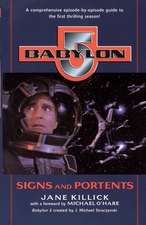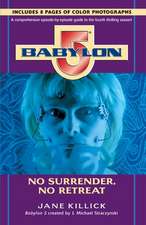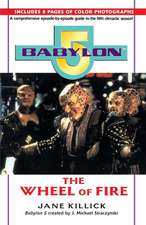The Coming of Shadows: Babylon 5, Season by Season, cartea 2
Autor Jane Killicken Limba Engleză Paperback – 31 mar 1998
Babylon 5: The Coming of Shadows, opens with "By Any Means Necessary: Making Babylon 5 on a Budget," a behind-the-scenes account of how series creator J. Michael Straczynski and his production team bucked the system to create the extraordinary twenty-first century world that would change the face of sci-fi TV. Then, in a thrilling second season overview, experience the arrival of Bruce Boxleitner as John J. Sheridan, new captain of the Babylon 5 station, and the looming threat of the sinister Shadows.
In-depth, episode-by-episode summaries--with detailed analysis by author and B5 expert Jane Killick--cover all of the second season's twenty-two shows, including "Points of Departure," "Spider in the Web," "Comes the Inquisitor," and the dramatic season finale, "The Fall of Night."
Veteran viewers or first-time fans, relive the adventure--or find out what you've been missing--with the complete companions to Babylon 5!
Preț: 87.68 lei
Nou
Puncte Express: 132
Preț estimativ în valută:
16.78€ • 18.28$ • 14.14£
16.78€ • 18.28$ • 14.14£
Carte disponibilă
Livrare economică 02-16 aprilie
Preluare comenzi: 021 569.72.76
Specificații
ISBN-13: 9780345424488
ISBN-10: 0345424484
Pagini: 192
Dimensiuni: 139 x 217 x 12 mm
Greutate: 0.26 kg
Ediția:American.
Editura: Del Rey Books
Seria Babylon 5, Season by Season
ISBN-10: 0345424484
Pagini: 192
Dimensiuni: 139 x 217 x 12 mm
Greutate: 0.26 kg
Ediția:American.
Editura: Del Rey Books
Seria Babylon 5, Season by Season
Extras
By Any Means Necessary: Making Babylon 5 on a Budget
Babylon 5 has changed the face of television science fiction with its
epic storyline, detailed futuristic world, intriguing Human and alien
characters, and its use of computer-generated special effects. But it
probably would never even have been made without its ability to stick to a
budget. The production model that makes Babylon 5 possible was so
ambitious in the beginning that many people didn't believe it could be
done.
Science fiction has a reputation for runaway budgets, and it's easy to
see why. When a series is set in the future, everything has to be designed
from scratch. While a contemporary show might put a desk in an office and
dress it with standard objects like a telephone, a desk diary, and a
computer, a futuristic show has to reinvent everything. If the show has
aliens, then they have to have makeup and specially designed costumes.
Special effects always add a large slice to the budget, especially with
shows set in space as creating inserts of spaceships or planets costs
money. Wandering space shows in the Star Trek mold incur even more expense
because they are constantly moving from place to place, requiring a new
alien world every week.
Babylon 5's producers knew the reputation of their genre, and they
were determined not to go down the runaway route that leads to
cancellation. At the heart of that determination was producer John
Copeland's production plan. It was an ambitious document right from the
start, and he remembers that even his own staff--production manager Kevin
G. Cremin and production accountant Sarah Fischer--was doubtful when he
showed it to them in the first season. "Both Kevin and Sarah looked at
this budget and said, 'You're out of your mind. You'll never do this!' "
One or two things gave the production an advantage over other shows,
however. The first was getting a commitment for a whole first season of
twenty-two episodes. This is extremely unusual for American television,
which usually commits for half a season to see how things go, how many
people tune in, and what the reaction of the advertisers is before
committing to the second half if things go well. The president of Warner
Bros. Domestic Television Distribution, Dick Robertson, remembers how
important that initial decision was. "That allowed us to put a lot more
money on the screen," he says. "We didn't have to pay holding fees to
actors; we didn't have to pay holding fees to the guy that owned the
building where we produced the show. We could commit up front for
twenty-two episodes, and the savings on that was probably at least
$300,000 an episode."
It gave the production the assurance of knowing exactly how much money
they had to spread over the first season and the freedom to make some big
decisions up front. One of the biggest was creating their own studio
complex in a warehouse on the outskirts of Los Angeles. At this time, many
American TV shows were relocating to Canada or even further afield in
search of lower production costs. This would have been more trouble than
it was worth for Babylon 5. Its reliance on postproduction and special
effects meant there was a real advantage to staying in L.A., where all
those facilities are on the doorstep.
"It was more efficient for us to come in here and build three
soundstages from the ground up," says John Copeland. "We had way more
space and way more control here than we ever would have had [in a
ready-made studio facility]. Where we shot the pilot, we had two little
soundstages side by side. We would just have had those two little
soundstages for a whole season. Our main stage, with the Observation Dome,
the customs bay, and the Central Corridor, is bigger out here than those
two soundstages were combined."
Another thing that sets Babylon 5 apart from many other shows is the
level of planning. While other shows have traditionally learned to cope
with last-minute scripts and late rewrites, Babylon 5 works four or five
scripts ahead of time. "That's one of the very unique facets of this
production," says John. "Very few other series have the ability to see
four or five episodes beyond the point that they are in any given time.
You can plan to spend your money that way. We have a budget for the
season, and we break that down into a pattern budget for what a typical
episode should cost--that's our yardstick for production. And we budget
every episode. So some of them will be right at that pattern; some of them
will be a little less. If we have come under budget on a few episodes, and
we know that down the road on episode eight, nine, or ten it's going to be
really ambitious, we can plan to spend extra money on that. Joe [J.
Michael Straczynski, executive producer and creator of Babylon 5] always
gives me a couple of pages at the beginning of a season, which is an
outline, so I can see where we're going and I can plan for things. One of
the fundamentals that we adopted going into this was, 'Okay, we're going
to have to make choices because of the economics we've got on Babylon 5,
and once we've made the choice, that means we've decided we're going to do
this, and the four things over here we're not going to do.' "
"We had to play what we call in American football 'no-mistakes
ball,' " says Kevin G. Cremin, who remained production manager for the
first two years. "We have to not make mistakes. We can't afford to build
something and then decide, 'We're really not going to shoot it that way;
we're going to have our back to that.' Everything that we'd built, once
we'd committed to it, we really had to stay with the idea. There wasn't
the luxury of being able to say, 'Well, nice idea, we'll try it later.' We
couldn't come up with something less than what the producers and directors
expected. We couldn't come up with a cheesy-looking prop or a
cheesy-looking costume or a cheesy-looking set. We always had to make sure
that if we could build a three-walled set and shoot in it and those three
walls were going to look substantially better than spending for the fourth
wall and then having to downgrade all of the dressing, then that was a
decision we had to make."
In terms of set design, the philosophy of making choices became what
the production designer, John Iacovelli, describes as a mantra for the
show. He had previously worked with the producers on Captain Power and the
Soldiers of the Future and was invited to draw up a plan for Babylon 5
before it was even commissioned because of his reputation for working on a
budget. "The basic elements of doing a show on a budget are knowing what
your budget is and being respectful of it," he says. "To make choices that
are very clear and to make the better choice rather than the idealized
choice, to make the choice you know you can win at, not the choice that
you know you may possibly lose at."
Those choices shaped the show in a variety of ways, particularly in
John's department, which designs and builds all the sets. "The money, and
how little we have of it, made so many decisions for us," he says. "For
example, the idea of putting contrasting colors and values on the sets in
a very textural way came from the fact that we couldn't afford the very
polished-looking sets that they have over at Trek and the other kinds of
shows. We just couldn't afford that kind of finish. So my point of view
was, like in the theater, if you've got to hide a bunch of staple holes,
wood grain, or something like that, then just paint it. It's almost like
camouflage. So that was one of the things that drove the show a lot in the
first season and second season, and it became successful--it gave the show
a kind of grittier look."
It is difficult to imagine Babylon 5 without that grittiness because
it fits in so well with the show's fictional reality. At the same time it
is a very dark show, which on the one level enhances the dramatic mood,
while on another serves to protect the viewer from seeing any rough edges.
Another aspect of the show that has helped keep the costs down as far
as sets are concerned is the fact that the story is centered on the space
station. There are occasional jaunts to Minbar or Centauri Prime, but on
the whole, the action stays in one place and that means keeping a certain
look throughout. A space station of this scale is built using modular
components, which allowed John Iacovelli to build modules and then reuse
them in various parts of the station. "I thought that if we had enough of
these kind of Lego building blocks, that we could have a lot of different
sets. A lot of the scenery, if you're very clever and you're a die-hard
fan, you'll see how we put it together. It's a miracle what a paint job
can do on a set. In fact, when we're designing a set, we often think 'What
do we have?' before 'What can we make?' Part of that came from my training
in the theater and being able to do a set for Shakespeare or for an opera,
where you have certain elements that are always the same, specific
elements that are specific to certain characters, specific to certain
groups, and the smallest change can make a huge visual difference. I think
the best example of that on Babylon 5 is the corridors. If we [use the
same set, but] change the color of the stripe and change the number of the
corridor, it [looks like] a completely different place. Visually, it looks
completely different, and I get the biggest rush out of that because it's
so simple."
A theater background is what unites some of the key people on the
Babylon 5 staff. That applies not only to John Iacovelli but to John
Copeland and Anne Bruice-Aling and her team of costumers. "We had all come
from a theater background, so we understand construction, we understand
fabrication, we understand budgets, and because we've come from theater
where the budgets are even tighter, we understand being resourceful," says
Anne. "I think that's helped us in a way that maybe other designers and
teams--having come up through television--may not have had that kind of
perspective. For me, it always feels like we're doing a big eclectic play
every week. It is like doing big theater that goes a lot faster.
"We have a budget that's doable," she continues. "What we did in the
beginning was decide where we were going to put our money. So we design
and build all of our alien things and some of the principal civilian
things, like the Lyta telepath things. We built those, and we used to
build all of Talia's things and all the uniforms, anything that's
specialized, the medlab and all that stuff. But for our civilian look, we
do buy off-the-rack, and we do what I call our 'Babylon tweak.' On men's
jackets, we take the lapels off, and we have strange collar things going
on. I buy certain kinds of shirts with interesting geometric patterns on
them, and we take all the collars off and change the buttons. Our
background civilians tend to be either very ethnically melting-pot things
and a lot of Indonesian and African and South American and Asian garments.
Then we mix and match them in strange ways that sort of suggest in the
future it will perhaps be more of a melting pot, and that keeps it
colorful. Then with contemporary Humans, we start with a basic black
underdressing, and I just try and find things that are clean smooth lines,
a little bit hip, and we do our little tweak to them. What Joe and John
have always said is that our department has really succeeded in putting
the money where you can see it."
Anne admits the first year was "pretty hellish" when the aliens, the
Humans, and the background characters all needed costumes. Fortunately,
many of the principal characters were in uniform most of the time and
didn't need a vast amount of wardrobe. That changed over time. "The
principals now all have their closets so to speak, so Sheridan has his
bathrobe and he has civilian wear and he has go-to-dinner kind of clothes.
But yeah, in terms of our principals, we don't have to augment them too
often. Delenn usually gets a couple of things every season, and Lennier
gets a couple of new things . . . For the background, most of the alien
stuff has now been built, with groups of Drazi pilots and Drazi merchants
and Minbari pilots and Minbari civilians, so it's not just the principals,
but the whole worlds that belong to them, we have now in stock which we've
designed and built."
Building up a stock of items to use became an invaluable asset for
almost every department. Obviously, in terms of costumes, it means being
able to cater for a crowd scene simply by pulling items out of the
storeroom. In terms of prosthetics, masks for background aliens become
stock items, while preexisting molds are available if others need to be
made. Even for special effects, once a Vorlon ship or a starfury has been
used for the first time, the model is available in the computer whenever
it is needed again. Stock sets also have a major part to play, and like
any other show, Babylon 5 has its basic sets, such as the Observation Dome
and the Zocalo, which, once paid for and erected on the soundstage, are
always there to be used and can even be redressed to look like somewhere
else.
But money cannot be made to rule the show. Babylon 5 is about telling
a story, and the production has to move to accommodate that. So, in terms
of sets, when the war heated up in season three, the casino set was
scrapped and replaced with the war room. Stock sets can be useful but are
not always appropriate, as in the second season when Sinclair was replaced
by Sheridan. "We had some really nice stuff for Sinclair's quarters in
season one," remembers John Iacovelli. "I felt really strongly that not
only should he [Sheridan] not be in the same physical place but that his
stuff should be almost completely different. That was a big expense,
because I felt visually there were certain things, certain paintings, that
we could not use again."
There are also certain areas where John Iacovelli and his staff try
not to scrimp and save. Sometimes it is necessary to spend the money,
particularly when it comes to what are known as the "hero props," things
like PPG rifles and links that are going to have significant screen time.
"This stuff is usually in close-up; it's usually next to somebody's face
or hand," says John. "Definitely with the props and gadgets, we try not to
scrimp, and I think that we are pretty successful in coming up with
interesting-looking things. There's also what we call 'the danger zone,'
which is about three and a half feet up on a set and for the next three
and a half feet. That's about where the close-ups happen on the set, and
that's the danger zone. I talk often to my staff, saying signing should be
very crisp there, all the dressing, any wood-screw holes, or anything has
to be cleaned up. We try to pitch it right around where the actors' faces
are because it is television and it is, ultimately, a show about talking
heads. Also, in the graphics, I think we've never scrimped. We've always
tried to put a lot of money into our graphics because all of us know what
a storytelling device that is."
It was John Copeland's philosophy from the beginning that the story
should be king. As far as he is concerned, it is his job to worry about
the money and the writers' job to worry about the creative side of the
process. "One of the lessons that I learned as a result of working on
Captain Power, which had a lot of special effects, [was that] we came up
with a lot of parameters of what you could have in a script and what you
couldn't have in a script, and ultimately, this was a handicap for the
writers. I wanted us to have a production process that didn't have
restrictions for the writers, and we just said, 'Write the story that you
want to tell, and we'll figure out how to do it.' "
Nevertheless, the show's executive producer, Joe Straczynski, who
started out writing most of the episodes in each season and progressed to
writing them all, never forgets that he is working within a budget. "My
feeling is if someone hands you $27 million to make a television show, it
behooves you to act responsibly," he says. "So I do try and do things I
know we can do, but what generally tends to happen is the production folks
come back to me and say, 'No, we can do more than this.' "
That is exactly what happened with the pilot script, as John Iacovelli
recalls: "I got the first script, and there was a very limited number of
sets--I wish I could find it, because I would love to compare it to the
script we ended up with . . . Basically, I felt that the writing at that
moment was being too cautious. I just encouraged him [Joe Straczynski]--I
said, 'Please don't write knowing that we don't have any money and we
don't have any sets: just write what you want, and somehow we'll figure it
out.' I think there's a tremendous trust that's developed between Joe and
myself and John Copeland. We know that there're things we won't be able to
do, and rarely do we say, 'Absolutely not, we can't do that'--we find a
way to do it. Sometimes we fail. Sometimes I'm just amazed by how good
some of the sets look."
"We're constantly finding the edge of the envelope," says John
Copeland. "When we find the edge of the envelope, we try to redefine what
is an envelope so that we can just go a little further."
Babylon 5 has changed the face of television science fiction with its
epic storyline, detailed futuristic world, intriguing Human and alien
characters, and its use of computer-generated special effects. But it
probably would never even have been made without its ability to stick to a
budget. The production model that makes Babylon 5 possible was so
ambitious in the beginning that many people didn't believe it could be
done.
Science fiction has a reputation for runaway budgets, and it's easy to
see why. When a series is set in the future, everything has to be designed
from scratch. While a contemporary show might put a desk in an office and
dress it with standard objects like a telephone, a desk diary, and a
computer, a futuristic show has to reinvent everything. If the show has
aliens, then they have to have makeup and specially designed costumes.
Special effects always add a large slice to the budget, especially with
shows set in space as creating inserts of spaceships or planets costs
money. Wandering space shows in the Star Trek mold incur even more expense
because they are constantly moving from place to place, requiring a new
alien world every week.
Babylon 5's producers knew the reputation of their genre, and they
were determined not to go down the runaway route that leads to
cancellation. At the heart of that determination was producer John
Copeland's production plan. It was an ambitious document right from the
start, and he remembers that even his own staff--production manager Kevin
G. Cremin and production accountant Sarah Fischer--was doubtful when he
showed it to them in the first season. "Both Kevin and Sarah looked at
this budget and said, 'You're out of your mind. You'll never do this!' "
One or two things gave the production an advantage over other shows,
however. The first was getting a commitment for a whole first season of
twenty-two episodes. This is extremely unusual for American television,
which usually commits for half a season to see how things go, how many
people tune in, and what the reaction of the advertisers is before
committing to the second half if things go well. The president of Warner
Bros. Domestic Television Distribution, Dick Robertson, remembers how
important that initial decision was. "That allowed us to put a lot more
money on the screen," he says. "We didn't have to pay holding fees to
actors; we didn't have to pay holding fees to the guy that owned the
building where we produced the show. We could commit up front for
twenty-two episodes, and the savings on that was probably at least
$300,000 an episode."
It gave the production the assurance of knowing exactly how much money
they had to spread over the first season and the freedom to make some big
decisions up front. One of the biggest was creating their own studio
complex in a warehouse on the outskirts of Los Angeles. At this time, many
American TV shows were relocating to Canada or even further afield in
search of lower production costs. This would have been more trouble than
it was worth for Babylon 5. Its reliance on postproduction and special
effects meant there was a real advantage to staying in L.A., where all
those facilities are on the doorstep.
"It was more efficient for us to come in here and build three
soundstages from the ground up," says John Copeland. "We had way more
space and way more control here than we ever would have had [in a
ready-made studio facility]. Where we shot the pilot, we had two little
soundstages side by side. We would just have had those two little
soundstages for a whole season. Our main stage, with the Observation Dome,
the customs bay, and the Central Corridor, is bigger out here than those
two soundstages were combined."
Another thing that sets Babylon 5 apart from many other shows is the
level of planning. While other shows have traditionally learned to cope
with last-minute scripts and late rewrites, Babylon 5 works four or five
scripts ahead of time. "That's one of the very unique facets of this
production," says John. "Very few other series have the ability to see
four or five episodes beyond the point that they are in any given time.
You can plan to spend your money that way. We have a budget for the
season, and we break that down into a pattern budget for what a typical
episode should cost--that's our yardstick for production. And we budget
every episode. So some of them will be right at that pattern; some of them
will be a little less. If we have come under budget on a few episodes, and
we know that down the road on episode eight, nine, or ten it's going to be
really ambitious, we can plan to spend extra money on that. Joe [J.
Michael Straczynski, executive producer and creator of Babylon 5] always
gives me a couple of pages at the beginning of a season, which is an
outline, so I can see where we're going and I can plan for things. One of
the fundamentals that we adopted going into this was, 'Okay, we're going
to have to make choices because of the economics we've got on Babylon 5,
and once we've made the choice, that means we've decided we're going to do
this, and the four things over here we're not going to do.' "
"We had to play what we call in American football 'no-mistakes
ball,' " says Kevin G. Cremin, who remained production manager for the
first two years. "We have to not make mistakes. We can't afford to build
something and then decide, 'We're really not going to shoot it that way;
we're going to have our back to that.' Everything that we'd built, once
we'd committed to it, we really had to stay with the idea. There wasn't
the luxury of being able to say, 'Well, nice idea, we'll try it later.' We
couldn't come up with something less than what the producers and directors
expected. We couldn't come up with a cheesy-looking prop or a
cheesy-looking costume or a cheesy-looking set. We always had to make sure
that if we could build a three-walled set and shoot in it and those three
walls were going to look substantially better than spending for the fourth
wall and then having to downgrade all of the dressing, then that was a
decision we had to make."
In terms of set design, the philosophy of making choices became what
the production designer, John Iacovelli, describes as a mantra for the
show. He had previously worked with the producers on Captain Power and the
Soldiers of the Future and was invited to draw up a plan for Babylon 5
before it was even commissioned because of his reputation for working on a
budget. "The basic elements of doing a show on a budget are knowing what
your budget is and being respectful of it," he says. "To make choices that
are very clear and to make the better choice rather than the idealized
choice, to make the choice you know you can win at, not the choice that
you know you may possibly lose at."
Those choices shaped the show in a variety of ways, particularly in
John's department, which designs and builds all the sets. "The money, and
how little we have of it, made so many decisions for us," he says. "For
example, the idea of putting contrasting colors and values on the sets in
a very textural way came from the fact that we couldn't afford the very
polished-looking sets that they have over at Trek and the other kinds of
shows. We just couldn't afford that kind of finish. So my point of view
was, like in the theater, if you've got to hide a bunch of staple holes,
wood grain, or something like that, then just paint it. It's almost like
camouflage. So that was one of the things that drove the show a lot in the
first season and second season, and it became successful--it gave the show
a kind of grittier look."
It is difficult to imagine Babylon 5 without that grittiness because
it fits in so well with the show's fictional reality. At the same time it
is a very dark show, which on the one level enhances the dramatic mood,
while on another serves to protect the viewer from seeing any rough edges.
Another aspect of the show that has helped keep the costs down as far
as sets are concerned is the fact that the story is centered on the space
station. There are occasional jaunts to Minbar or Centauri Prime, but on
the whole, the action stays in one place and that means keeping a certain
look throughout. A space station of this scale is built using modular
components, which allowed John Iacovelli to build modules and then reuse
them in various parts of the station. "I thought that if we had enough of
these kind of Lego building blocks, that we could have a lot of different
sets. A lot of the scenery, if you're very clever and you're a die-hard
fan, you'll see how we put it together. It's a miracle what a paint job
can do on a set. In fact, when we're designing a set, we often think 'What
do we have?' before 'What can we make?' Part of that came from my training
in the theater and being able to do a set for Shakespeare or for an opera,
where you have certain elements that are always the same, specific
elements that are specific to certain characters, specific to certain
groups, and the smallest change can make a huge visual difference. I think
the best example of that on Babylon 5 is the corridors. If we [use the
same set, but] change the color of the stripe and change the number of the
corridor, it [looks like] a completely different place. Visually, it looks
completely different, and I get the biggest rush out of that because it's
so simple."
A theater background is what unites some of the key people on the
Babylon 5 staff. That applies not only to John Iacovelli but to John
Copeland and Anne Bruice-Aling and her team of costumers. "We had all come
from a theater background, so we understand construction, we understand
fabrication, we understand budgets, and because we've come from theater
where the budgets are even tighter, we understand being resourceful," says
Anne. "I think that's helped us in a way that maybe other designers and
teams--having come up through television--may not have had that kind of
perspective. For me, it always feels like we're doing a big eclectic play
every week. It is like doing big theater that goes a lot faster.
"We have a budget that's doable," she continues. "What we did in the
beginning was decide where we were going to put our money. So we design
and build all of our alien things and some of the principal civilian
things, like the Lyta telepath things. We built those, and we used to
build all of Talia's things and all the uniforms, anything that's
specialized, the medlab and all that stuff. But for our civilian look, we
do buy off-the-rack, and we do what I call our 'Babylon tweak.' On men's
jackets, we take the lapels off, and we have strange collar things going
on. I buy certain kinds of shirts with interesting geometric patterns on
them, and we take all the collars off and change the buttons. Our
background civilians tend to be either very ethnically melting-pot things
and a lot of Indonesian and African and South American and Asian garments.
Then we mix and match them in strange ways that sort of suggest in the
future it will perhaps be more of a melting pot, and that keeps it
colorful. Then with contemporary Humans, we start with a basic black
underdressing, and I just try and find things that are clean smooth lines,
a little bit hip, and we do our little tweak to them. What Joe and John
have always said is that our department has really succeeded in putting
the money where you can see it."
Anne admits the first year was "pretty hellish" when the aliens, the
Humans, and the background characters all needed costumes. Fortunately,
many of the principal characters were in uniform most of the time and
didn't need a vast amount of wardrobe. That changed over time. "The
principals now all have their closets so to speak, so Sheridan has his
bathrobe and he has civilian wear and he has go-to-dinner kind of clothes.
But yeah, in terms of our principals, we don't have to augment them too
often. Delenn usually gets a couple of things every season, and Lennier
gets a couple of new things . . . For the background, most of the alien
stuff has now been built, with groups of Drazi pilots and Drazi merchants
and Minbari pilots and Minbari civilians, so it's not just the principals,
but the whole worlds that belong to them, we have now in stock which we've
designed and built."
Building up a stock of items to use became an invaluable asset for
almost every department. Obviously, in terms of costumes, it means being
able to cater for a crowd scene simply by pulling items out of the
storeroom. In terms of prosthetics, masks for background aliens become
stock items, while preexisting molds are available if others need to be
made. Even for special effects, once a Vorlon ship or a starfury has been
used for the first time, the model is available in the computer whenever
it is needed again. Stock sets also have a major part to play, and like
any other show, Babylon 5 has its basic sets, such as the Observation Dome
and the Zocalo, which, once paid for and erected on the soundstage, are
always there to be used and can even be redressed to look like somewhere
else.
But money cannot be made to rule the show. Babylon 5 is about telling
a story, and the production has to move to accommodate that. So, in terms
of sets, when the war heated up in season three, the casino set was
scrapped and replaced with the war room. Stock sets can be useful but are
not always appropriate, as in the second season when Sinclair was replaced
by Sheridan. "We had some really nice stuff for Sinclair's quarters in
season one," remembers John Iacovelli. "I felt really strongly that not
only should he [Sheridan] not be in the same physical place but that his
stuff should be almost completely different. That was a big expense,
because I felt visually there were certain things, certain paintings, that
we could not use again."
There are also certain areas where John Iacovelli and his staff try
not to scrimp and save. Sometimes it is necessary to spend the money,
particularly when it comes to what are known as the "hero props," things
like PPG rifles and links that are going to have significant screen time.
"This stuff is usually in close-up; it's usually next to somebody's face
or hand," says John. "Definitely with the props and gadgets, we try not to
scrimp, and I think that we are pretty successful in coming up with
interesting-looking things. There's also what we call 'the danger zone,'
which is about three and a half feet up on a set and for the next three
and a half feet. That's about where the close-ups happen on the set, and
that's the danger zone. I talk often to my staff, saying signing should be
very crisp there, all the dressing, any wood-screw holes, or anything has
to be cleaned up. We try to pitch it right around where the actors' faces
are because it is television and it is, ultimately, a show about talking
heads. Also, in the graphics, I think we've never scrimped. We've always
tried to put a lot of money into our graphics because all of us know what
a storytelling device that is."
It was John Copeland's philosophy from the beginning that the story
should be king. As far as he is concerned, it is his job to worry about
the money and the writers' job to worry about the creative side of the
process. "One of the lessons that I learned as a result of working on
Captain Power, which had a lot of special effects, [was that] we came up
with a lot of parameters of what you could have in a script and what you
couldn't have in a script, and ultimately, this was a handicap for the
writers. I wanted us to have a production process that didn't have
restrictions for the writers, and we just said, 'Write the story that you
want to tell, and we'll figure out how to do it.' "
Nevertheless, the show's executive producer, Joe Straczynski, who
started out writing most of the episodes in each season and progressed to
writing them all, never forgets that he is working within a budget. "My
feeling is if someone hands you $27 million to make a television show, it
behooves you to act responsibly," he says. "So I do try and do things I
know we can do, but what generally tends to happen is the production folks
come back to me and say, 'No, we can do more than this.' "
That is exactly what happened with the pilot script, as John Iacovelli
recalls: "I got the first script, and there was a very limited number of
sets--I wish I could find it, because I would love to compare it to the
script we ended up with . . . Basically, I felt that the writing at that
moment was being too cautious. I just encouraged him [Joe Straczynski]--I
said, 'Please don't write knowing that we don't have any money and we
don't have any sets: just write what you want, and somehow we'll figure it
out.' I think there's a tremendous trust that's developed between Joe and
myself and John Copeland. We know that there're things we won't be able to
do, and rarely do we say, 'Absolutely not, we can't do that'--we find a
way to do it. Sometimes we fail. Sometimes I'm just amazed by how good
some of the sets look."
"We're constantly finding the edge of the envelope," says John
Copeland. "When we find the edge of the envelope, we try to redefine what
is an envelope so that we can just go a little further."
Descriere
Includes Killick's essays "By Any Means Necessary: Making "Babylon 5" on a Budget" and ""Babylon 5's" Second Season"; a complete guide to and analysis of the season's 22 episodes, including "Point of Departure", "Hunter's Prey", and "The Fall of Night". Web page feature.


















